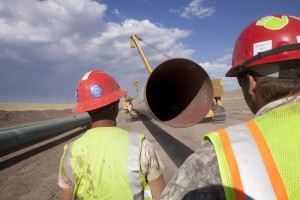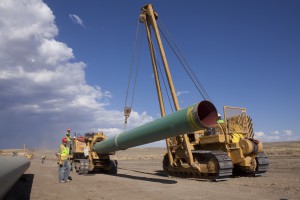May 2011, Vol. 238 No. 5
Features
TransCanadas Newest U.S. Asset: Bison Pipeline

So far in 2011, TransCanada has been making a lot of news, although some of the notoriety has been unwanted. The large-diameter pipeline operator opened its new 305-mile, 30-inch diameter Bison Pipeline between the Rockies and the Midwest in January, but that milestone was somewhat upstaged by major pipeline incidents on both sides of the U.S.-Canada border that preceded and followed it.
And one of them in February involved a part of TransCanada’s Main Line across Canada in Ontario province close to the town of Beardmore (pop. 345). Both milestones tend to animate TransCanada executives who are steeped in the care and feeding of high-pressure, long-distance gas pipelines.
Bison is the company’s latest example of its attention to detail, which was heightened with this project’s commissioning that came a few months after the fatal rupture of a 30-inch diameter intrastate transmission pipeline operated by Pacific Gas & Electric Co. on the peninsula south of San Francisco, CA. Undaunted, TransCanada’s Dean Ferguson, vice president of U.S. pipelines in the West, and Calgary-based David Chittick, director of pipeline integrity, told P&GJ that they see the Bison pipeline as another chance to serve new gas markets and do it as safely and seamlessly as possible.
Chittick notes that unlike the 36-inch diameter Mainline segment in Canada that was installed nearly 40 years ago, Bison is designed and managed to an enhanced standard including the more stringent requirements for an “alternative maximum allowable operating pressure” (MAOP) to operate at 80% of the pipe’s tested maximum strength.
“In essence, it calls for the pipeline being treated like it runs through a high consequence area (HCA) for its entire length,” Chittick says. “It calls for more frequent inline inspections, and other steps.”
Unlike most pipelines that operate at the 72% level, Bison’s pressure is 80% of its pipe’s maximum yield strength. This more stringent operating authorization drives a higher level of scrutiny from the federal Pipeline and Hazardous Materials Safety Administration (PHMSA) as far as the pipeline’s construction practices and records that went along with them, Ferguson says. It is one of the primary reasons that TransCanada kept pushing back its start date for Bison from late fall to early winter. Regulators wanted more tests and assurances to support the 80% standard.

“There was a concerted effort with PHMSA to go through a comprehensive review and validate the construction practices to determine that all of what we did was appropriate before we were given the authorization to go into service at the 80% design level,” Ferguson says.
Bison is the product of rapidly changing economics and dynamics in the North American gas sector. It was conceived at a fever pitch time for moving Wyoming Powder River Basin supplies east and was one of two major pipeline proposals TransCanada was looking at just three years ago. At one time there was a larger Pathfinder project that dipped farther south into other Rockies’ supply basins with 36- and 42-inch diameter segments and a length twice as long as Bison and a 1 Bcf overall capacity.
When it was consolidated into Bison in mid-2009, TransCanada said that eventually Bison could pick up the 1 Bcf overall capacity and initially it would run at 477 MMcf/d capacity with the help of an added compressor. That compression has now been delayed for at least two years in a filing the project made last year to the Federal Energy Regulatory Commission (FERC). According to TransCanada’s Ferguson, it is all a response to a changed market.
“Certainly we’ll pursue the growth of Bison as activity levels pick back up in the Rockies,” he says, noting that TransCanada is constantly looking for ways to continue to grow Bison. “Our immediate focus will be on making sure we can get the necessary underpinning (market interest) to proceed with the compression expansion (for the 477 MMcf/d capacity).
“We don’t have a timetable, but we’re always interested in that growth. We’ll pursue it actively when it develops.”

TransCanada sees the Powder River Basin growth now as flat. “Certainly the activity levels that would underpin the 1 Bcf/d growth projections have disappeared for now. So, our near-term expectations, and those of others in the industry, would be that we would not expect that type of growth for awhile. The Powder River in the near-term is more like something flat.”
At the 407 MMcf/d operating level Bison performed very well this past winter, according to Ferguson. It has provided a boost to the market moving gas east, and the commissioning and initial integrity management work has now been completed, but the ongoing management is never ending, particularly with a pipeline operating at the 80% standard.
TransCanada’s Chittick says Bison is one of the few pipelines in the United States sanctioned to operate at 80% of the “specified minimum yield strength (SMYS).” In its simplest terms, SMYS is the highest theoretical level of operating pressure and something less than the pipe’s “ultimate strength,” or breaking point, he says.
In preparing Bison for its commercial debut last January Chittick developed a maintenance/integrity effort from two standpoints: (1) meeting what he calls “pure compliance aspects” for all U.S. regulations (Code of Federal Regulation 192.620, for gas pipeline transportation) covering natural gas and liquids pipelines, and (2) satisfying areas not covered by the regulations, but important from an essential safety perspective.
“The (federal U.S.) codes themselves are really focused on more of the (populated) high consequence areas, but TransCanada and other operators have maintenance programs for all of our pipelines, not just in HCA areas,” Chittick says. “When we bring on new pipelines, such as Bison and others that are built with conditions that are incrementally above a typical pipeline (offering 80% operating pressure) we have to do it with a special permit or the relatively new regulations.”
In Bison’s case, PHMSA reviewed the pipeline’s design, construction and audit records and provided an oral response, a TransCanada spokesperson says. “Pipelines constructed after the new (192.620) regulations do not have special permits.”
Most, but not all, of Bison is operating at the 80% standard. Chittick says that he considers it an 80%, or higher standard, pipeline, but a small amount of the pipe at the beginning of the line was supplied by one of the shippers, so TransCanada will not consider it as part of the 80% tested pipe.
After only a month of operation, Chittick reported that there was a long list of “incremental activities” that the Canadian pipeline firm was performing – “all above and beyond what we do for a 72% pipeline.”
Examples of some of that work include: Ongoing cathodic protection, and – within six months – completion of a “close-interval survey” along the entire pipeline length to validate the protection is doing what it is supposed to. This means that field operators, carrying an array of electronic gear strapped to their backs, literally walk the entire pipeline, taking measurements of the ground and the pipe every three to five feet. Within three years, TransCanada is required to run “high- resolution” inspection tools inside the pipe.
“On Bison, despite the fact that there is no HCA, as an 80% line the requirement is to run this within three years,” Chittick says. “Normally, you wouldn’t run this for 12 to15 years, if it is a new pipe with high-quality coating in a rural area. These are things you don’t need to do on a typical pipeline, but are requirements for an 80% line.”
In dealing with the tougher, 80% requirements the criteria for when pipeline operators need to repair “features” (anomalies, imperfections) found in the pipeline differ, too. Chittick notes that Bison will need to repair them earlier compared to a typical pipeline. In a typical pipeline you could recoat an imperfection, but in an 80% pipeline you might need to add a physical sleeve,” he says.
“For brand-new pipelines like Bison, they are all built with state-of-the-art elements – high-performance coating systems, fusion-bonded epoxy (FBE) – and they will be in place for 20 or 30 years before they need any repairs, but they will all have a lot of maintenance inspection work.”
Chittick says the FBE came into play about 20 years ago. “We do inspections of these in the HCA areas every seven years, but the coating system really has proven itself.”
The key is a complete supply line tracking system to make sure every piece of equipment in the pipeline can be traced to manufacturer, supplier and pre-installation testing.
“You have to have a very detailed, high-quality management system for the procurement of the products, construction, frequent audits, inspections from PHMSA, all your documentation must be perfect, showing where pipe was purchased, all the testing done on it, and you need ‘trace-ability’ to every component in the pipeline.”
TransCanada also invests in what Chittick calls “incremental, special training” for workers involved in construction of the pipeline. U.S. federal regulations require proof they have been trained, above and beyond what is normal and then to higher-level hydro-static testing.
“From my perspective of managing integrity, there is no difference whether the pipeline is 80% or 72%,” Chittick says. “I have documented no incremental difference in incidents between the two.”
——————–
Mainline Break
While the failure in a natural gas pipeline is a totally unwelcome event for a line’s operator, the case of TransCanada’s Mainline rupture in Ontario, Canada at least gave company officials the comfort of knowing the massive national pipeline system performed exactly as designed in response to the failure.
As one of three parallel high-pressure transmission pipelines (30- , 36- and 42-inch diameter), the 36-inch Line 2 ruptured last Feb. 19 in a rural area 1.24 miles from Beardmore and 105 miles northeast of Thunder Bay, Ontario, but TransCanada was able to keep gas flowing on its major national Canadian pipeline system.
Its gas control center in Calgary detected a drop in pressure and operators were able to remotely shut down valves on both sides of the rupture within five minutes, according to company officials. Canadian national regulatory investigators were on the scene the next day (Feb. 20).
That same response is built into Bison, according to Director of Pipeline Integrity David Chittick.
Bison pipeline has “incremental integrity requirements” going beyond the standard applied to the Canadian Mainline pipelines. “Bison is managed to our standard program, plus it is enhanced by all the quite considerable requirements for the alternative maximum allowable operating pressure (MAOP) standard (80%),” Chittick says
All block valves in Bison have line-break detection on them, so in the event of any failure the pipeline segments, especially on a single line, the rupture can be isolated very quickly, he says. Even with the three lines on the Mainline system, the upstream and downstream valves isolated the segments.
Last February when TransCanada was “just pulling the (mainline) pipe out of the ditch,” Chittick would not speculate on the cause, but he was “confident that corrosion was not involved.” In this case, the company was looking at external damage to the line from dents and gouges.
In terms of his company’s operational response, Chittick says “you couldn’t ask for anything better; it operated the way it was engineered to do so. Within minutes, the valves were closed, and when gas control switches quickly, they isolate a larger area as well.”
—————————–
Author
Richard Nemec is West Coast Correspondent for P&GJ. He can be reached at: rnemec@ca.rr.com.





Comments